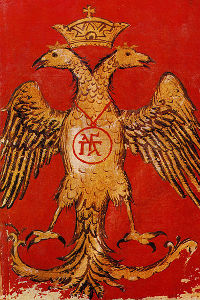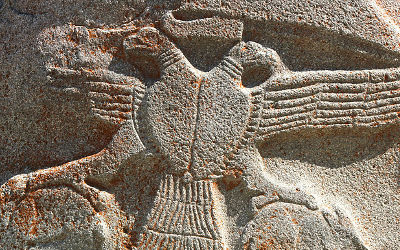Phoenix
The phoenix, depicted as a double-headed eagle, is a pun-animal which was likely written like פן-נקז ˁp-nqz in the Semitic languages. This means “double-beak”, and puns with פן-נכס pn-nks, which means “exchange-wealth”, i.e. banking. The phoenix was thus a pun on “turning” & “doubling”, complemented with other aspects where it “re-turned” to Egypt, or “re-turned” to life.

Double-headed “eagle” of Byzantine emperor John VIII Palaiologos,
very phoenix-like with long neck and exaggerated tail feathers.
Phoenix puns in a nutshell
Like all mythical animals, the phoenix seems to have been created from puns. In this case, it’s P-N-K puns that describe it. The phoenix is a bird, because several birds or bird features use the pattern P-N-K.
Most phoenix puns use the prefix pn, which means “turning” & “curving”, in Phoenician and nearly every other language. If anything with a K-ish name is “turned”, you get a “phoenix”. That’s why the phoenix has a “curved” beak, a “curved” neck and “returns” to life.
Since the Phoenician language was a large group of dialects spoken in the regions that later spoke Hebrew, Aramaic and Arabic, words from all these languages would have been known by Phoenician speakers.
The phoenix is a double-headed bird, probably because Semitic עף-נקז ˁp-nqz means “double-beak”. עף ˁp is “double”, and נקז nqz means “puncturer” / “beak”. 🡻
The phoenix is an eagle, probably because Semitic פנא-נקז pnˀ-nqz means something like “sharp-beaked eagle”. Several eagles & vultures were named פנא pnˀ in Aramaic, likely for their curved beaks. נקז nqz means “beak”, see above. 🡻
The phoenix is a heron in Egypt, because Egyptian bnw means “heron”, probably for its curved neck. 🡻
The phoenix must have a long & wound neck, because פן-אנק pn-ˁnq means “wound neck”. Even in English, saying “wound neck” still sounds a bit like “phoenix” (W-N-K). In Egyptian, this would be bn-ḫḫ, that’s why the Egyptian phoenix is a heron. 🡻
The phoenix must have a curved beak, because פן-נקז pn-nqz means “curved beak”.
The phoenix may also have two heads, because that is a depiction of turning the neck left & right. In Semitic, “turning the neck” would be the same as a “curved neck”, and written פן-אנק pn-ˁnq.
The phoenix burns itself, perhaps for a pun with עוף-נכוה ˀwp-n-kwh “self-burning bird”. (To get the N-prefix, you need the Niph‘al reflexive form). 🡻
The phoenix returns from ashes, perhaps for a pun with “return [from being] burned”, which would be פן-כוי pn-kwy, though the preposition “from” is missing. 🡻
The phoenix returns to life, probably because פן-חי pn-ḥy means “return [to] life” (for the letter similarity, see Ḥet ≈ Kaph). In Egyptian, “return [to] life” would be pn-ˤnḫ, for the Ankh, so the pun works there as well. 🡻
The phoenix is often a symbol for purity, because בנקיו b-nqyw means “in purity”. This pun chimes well with the renewal after cauterization.
The phoenix is often a symbol for royalty, probably because archaic Greek ϝαναξ wanax means “king”.
But as usual, that’s not all. The ancient punners discovered that some nasty meanings also follow the pattern P-N-K, so the phoenix was promoted to a major symbol of spookery by the secret aristocracy.
The phoenix is a spook symbol and a hoax marker, because Greek φεναξ phenax means “fraud” & “deception”, even “impostor”. This word may even have a Phoenician etymology, from Semitic פן-קשט pn-qšṭ “perverting the truth”. 🡻
The phoenix may be a symbol for banking & trade, because פן-נכס pn-nks means “exchange of wealth” & “exchange of accounts” (see Phoenicians). This may be the reason why a double-headed eagle was the symbol of Ancient Hattusa and Byzantium. 🡻.
The phoenix is a symbol for banking, also because Latin foenus means “finance”. The word finance itself is still somewhat similar to phoenix. It may even have a Phoenician etymology, see above.
The phoenix is also a spook symbol in the sense that the pun appears on portraits: Many spooks have themselves portrayed in profile, brandishing their noses to look extra-curvy: The phoenix puns with אף-נקז ˀp-nqz for “beaky nose”!
Phoenix as a bird
The phoenix must be a bird because the word phoenix puns with bird names & attributes:
- Semitic עוף ˁwp generally means “bird”.
- In Aramaic, פנא pnˀ was a name for several birds of prey, including eagles. It’s likely derived from the word root √pn for “turning”, for their curved beaks.
- נקז nqz means “beak”, derived from “puncturing” & “pecking”. The compound term pnˀ-nqz would thus mean something like “sharp-beaked eagle”.
- Since in Aramaic Zayin is similar to Dalet, the phoenix also puns with pnˀ-nqd, which would be the “spotted eagle”. (The roots √nqz and √nqd are officially related.)
- In Egyptian, bnw means “heron”. The same word is also often translated as “phoenix”. It’s likely again derived from the word root √pn for “turning”, this time for the curved neck. Egyptian bˤn.t means “neck”, with a female T-suffix.
Hebrew, Aramaic pnˀ = various birds of prey; ˁwp = bird; pn = turn; nqwz = beak; ˁnq = neck
עוף ˁwp : fowl, bird — Hebrew (Klein)
ܦܢܐ pnˀ : an ossifrage, a lammergeier (bearded vulture-eagle); a young sea-eagle, an osprey / a loon / a diver — Syriac (AAF)
פאנא ; פאן pˀn; pˀnˀ : a type of falcon — Aramaic (CAL)
פנה pnh : to turn; turned — Hebrew (Klein)
נקוז nqwz : beak — Aramaic (CAL)
ענק ˁnq : neck — Hebrew (Jastrow)
Egyptian bnw = heron; bˤn.t = neck, beak; ḫḫ = neck
Double-headed eagle as phoenix
Miles famously deduced that the double-headed eagle is in fact a phoenix. The fact that the double-headed eagle is equivalent to a phoenix seems to be a half-open, but misrepresented secret. Hundreds of spooky books on mysticism and faux truther sites on freemasonry name the famous double-headed eagle as a phoenix. But as far as admission in official heraldry goes, I only found the crest of the USS Makin Island: “From a wreath Argent and Azure a double-headed phoenix of the like rising from flames Proper”.
The true reason why a phoenix is the same as a double-headed eagle is simply that it’s a pun with the word phoenix: The phoenix puns with פנא-נקז pnˀ-nqz for “sharp-beaked eagle” (see above). You can take the Aramaic term עף ˁp “double”, and extend this word to עף-פנא-נקז ˁp-pnˀ-nqz “double-beaked-eagle”, or simply change it to עף-נקז ˁp-nqz “double-beak”. Both pun with phoenix, and that’s why the phoenix is a double-headed bird.
(Interestingly, the word root √ˁp means “double”, and also “bird”. Both are derived from “folding over”, as in folding wings.)
Aramaic ˁp = fold, double, doubled
עף ˁp : double; -fold; -times — Aramaic (CAL)
אעף ˀˁp : double, copy; doubly; -times — Aramaic (CAL)
עפי ˁpy : to be bent; to spread, be doubled — Hebrew (Jastrow)
עפף ˁpp : to double; fold; to plait, fold; to wrap up; to conjoin; to be entwined; to be doubled; to repeat; to be repeated, duplicated — Aramaic (CAL)
Aramaic nqz = puncture, beak
Phoenix as burning & returning to life
If you’re allowed to omit prepositions like “from” & “to”, then the phoenix also puns with פן-כוי pn-kwy “return [from being] burned”, and with פן-חי pn-ḥy “return [to] life”. Since Ḥet ≈ Kaph, this is still a valid P-N-K phoenix pun. In fact, since Jastrow’s dictionary translates pnˀ as “turning to or from”, without the prepositions, it may even have been a valid phrase.
The phoenic burns itself, perhaps because the Hebrew Niph‘al form with an N-prefix can have a reflexive meaning, i.e. “oneself”. The phrase עוף-נכוה ˀwp-n-kwh can thus mean “self-burning bird”. The consonants are still P-N-K, so it’s a phoenix.
Aramaic pn = turn, return; kwy = burn; ḥy = alive
פני ; פנא pny; pnˀ : to turn to or from; to go; to remove, empty — Hebrew (Jastrow)
פני pny : to turn; to face; to return; to do something again; to give back; to turn something; to turn back; to convert — Aramaic (CAL)
כוא ; כוה ; כוי kwy; kwh; kwˀ : to sear, cauterize; to scald; burn-marked, flame-spotted; to be burnt; to be cauterized — Hebrew (Jastrow)
חי ḥy : alive, living — Hebrew (Klein)
Hebrew, Aramaic ˁwp = bird; n-kwh = burned, scorched
Phoenix as hoax marker
The phoenix seems to be used as a hoax marker by the spooks. That’s probably because it puns with Greek φεναξ phenax for “fraud” & “deception”, which even means “impostor”. This is exactly what the spooks are.
It’s possible that this term has a Semitic etymology, perhaps from פן-קשט pn-qšṭ “perverting the truth”.
For the full set of derived words, see the word root √pn.
Greek phenax = cheat, deception, liar, fraud, impostor
φέναξ phenax : a cheat, quack, impostor; perhaps with a play on phoinix (the bird); in Eq.634 Phenakes are addressed as the tutelary gods of cheats; a fraudster, deceiver, liar — Ancient Greek (LSJ.gr)
φενακίζω phenakizo : play the phenax, cheat, lie; deceptive appearance; (trans.) to cheat, trick; (pass.) to be cheated; to deceive, beguile, cheat; to achieve by lying, falsely pretend, falisify — Ancient Greek (LSJ.gr)
Double-headed phoenix as a symbol for trade
The double-headed eagle or phoenix was especially important in the regions that connected Asia & Europe. It has been the symbol of Russia, Serbia, Albania, Byzantium, down to the Ancient Hittite empire. This may be a pun of ˁp-pnˀ-nqz “double-beaked eagle” with pn-nks “exchange of wealth”, pointing to trade. The word roots √pn and √nks even exist in many other languages as well, so this was international vocabulary.

Hittite relief of double-headed eagle
inside of Alaca Höyük sphinx gate
The double-headed Hittite eagle on the sphinx gate in Alaca Höyük near Hattusa is especially interesting, because the fortifications are dated to th 13th and 14th century BC. That is well before the alleged fall of the Hittite empire in the Late Bronze Age Collapse, typically dated to “around 1180 BC”. If both datings are correct (and I’m not so sure either one is), then the symbolism of the Old Hittite empire was already ripe with spook punnery. This would then mean that the Old Hittite elites were already globalized spooks, and thus not victims of the Late Bronze Age Collapse.
But the punny trail has to end somewhere. The Scottish freemasons named their phoenix “Eagle of Lagash”, in an attempt to go even further. Now Lagash did use lion-headed eagles as symbols, as seen on a Girsu relief and the vase of Entemena. But that creature has no beak, no long neck, and just a single head, and is therefore no phoenix. If it really was a pun, it was likely a very different one, in Sumerian. My guess is the mason spooks just randomly picked the oldest pagan eagle motif they knew of, to appear as mystic & Satanistic as possible. Since phenax means “fraud”, they still “pulled a phoenix” in this sense.
